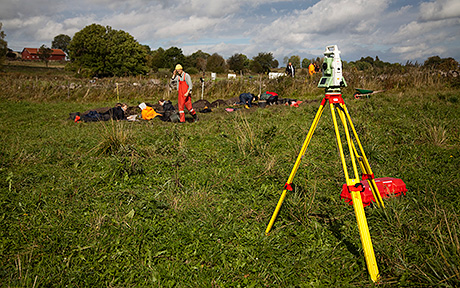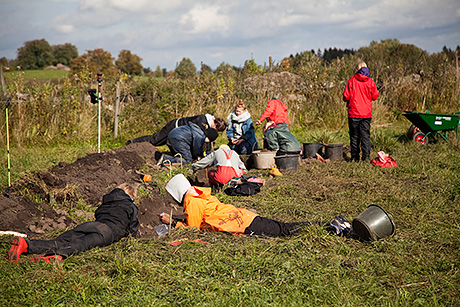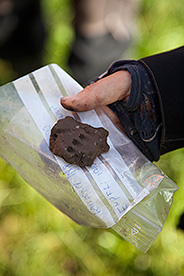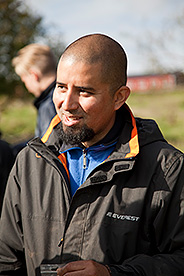- Home
- News and events
- Find news
- Excavations reveal agriculture of 5,000 years ago
Excavations reveal agriculture of 5,000 years ago
 The early nature of agriculture and its economic and social significance is a matter of debate among archaeologists. For three years, researchers and students from the University of Gothenburg have engaged in archaeological excavations of a 5,000 year old settlement in Karleby right outside of Falköping, in a search for the answer.
The early nature of agriculture and its economic and social significance is a matter of debate among archaeologists. For three years, researchers and students from the University of Gothenburg have engaged in archaeological excavations of a 5,000 year old settlement in Karleby right outside of Falköping, in a search for the answer.
A small gravel road winds through a farm, further down a slope until it ends at a white party tent standing upright in the corner of a grassy field. Next to the tent, which serves both as an eating area for hungry archaeologists and a storage space for the excavated finds, stands Karl-Göran Sjögren, who leads the excavation together with his colleague Tony Axelsson.“If we don’t move the soil, we won’t get anywhere”
“There was one settlement over here, another one over there, a third settlement was there, and a fourth a bit further up the hillside,” explains Karl-Göran Sjögren as he points out those locations.
Small elevations or berms in the cultivated landscape reveal where he and his colleagues have dug previously. Archaeologists from the University of Gothenburg have been studying the Stone Age society in Vastergotland for a long time, but excavations have been systematically underway in Karleby since 2012.
The excavations have revealed a system of settlements that are contemporaneous with the known passage graves in Karleby, which are lined up in the cultivated landscape west of the road through the town. The habitations are on the other side of the road, hidden from the passage graves in a sloping field behind a farm.
 “We are not talking about large settlements here. There was room for one or two houses, and around them were the areas that people cleared and where the animals grazed. In the hillside slope, it was a bit more open than today and in the valleys, a dense forest. Most likely there was a road system between the settlements, served by ox-carts,” explains Karl-Göran.
“We are not talking about large settlements here. There was room for one or two houses, and around them were the areas that people cleared and where the animals grazed. In the hillside slope, it was a bit more open than today and in the valleys, a dense forest. Most likely there was a road system between the settlements, served by ox-carts,” explains Karl-Göran.
The goal with the excavations is to find out how the basal agricultural economy worked here 5,000 years ago. Scientists have found both well-preserved animal bones (cattle, pigs and sheep) and cereal grains, important clues that can help them understand the agriculture’s character and relationship to cattle raising.
Was it a shifting cultivation or a more intensive use of the land, with permanent cleared areas that might have been fertilised? To answer this question, Karl-Göran and his colleagues enlisted the help of scientific methods.
“We have made various analyses and found elevated levels of the Nitrogen 15 isotope in cereal grains, which suggests that those who lived here fertilised the fields as early as 5,000 years ago. We are speaking of stable fields and not a shifting cultivation. By studying the content of different isotopes in animal bones, we also see that many cows are not raised in the area, so therefore there was some kind of exchange or circulation system.”
 Across the field, some figures dressed in colourful rain and work wear are proof of an archaeological excavation in progress. A well-trodden path leads to the digging site consisting of a number of so-called meter boxes, the excavated soil chunks, approximately 40–45 centimetres deep down to the settlement layer, which are examined by means of shovels, trowels, cutting ladles and small buckets. Some of the metre boxes are excavated next to each other in a long line, in order to thus follow the distribution of the finds.
Across the field, some figures dressed in colourful rain and work wear are proof of an archaeological excavation in progress. A well-trodden path leads to the digging site consisting of a number of so-called meter boxes, the excavated soil chunks, approximately 40–45 centimetres deep down to the settlement layer, which are examined by means of shovels, trowels, cutting ladles and small buckets. Some of the metre boxes are excavated next to each other in a long line, in order to thus follow the distribution of the finds.
On opposite sides of a single box sits Belinda Stenhaug and Wendy Rundström, on their knees and scraping in soil in a yellow scoop using cutting ladles. They are two of the nine archaeology students who are participating in this autumn’s two-week survey.
“It is instructive to sit here with my nose in the ground, to wipe off, start digging, finding finds, straining and rinsing, and the final identification of what you find, reports Wendy. There is a big difference from sitting on a school bench and looking at the findings that others have excavated.”
“Finding small fragments and making sure that it is not stone but rather burned bones, it’s a lot of fun and educational, Belinda adds. And it’s incredibly awesome to start thinking about a human who created a ceramic object 5,000 years ago, and here I am finding it today.”
A short distance away is Malou Blank, a doctoral researcher in archaeology, in the process of digitally documenting the excavation. With the help of what is known as a total station, she produces a digital map by accurately measuring out the excavated squares, stone formations and other interesting objects.
“ It’s really a lot of fun digging, she reports. And it’s interesting for the students to come here, there are very many finds in the ground. They learn to recognise pottery, flint and burned and unburned bones, preserved thanks to the calcareous soil.”
It’s really a lot of fun digging, she reports. And it’s interesting for the students to come here, there are very many finds in the ground. They learn to recognise pottery, flint and burned and unburned bones, preserved thanks to the calcareous soil.”
Malou takes up the largest pottery shard they found out of a neatly labelled findings bag and places it gently in the palm of her hand. It is a few centimetres long and decorated with so-called cross betting patterns. The curvature reveals that it concerns a piece from a large pot. But like all other finds, the pot has been crushed and ground down through the millennia.
“What we are talking about is fragmented remnants scattered over such a long period of time, therefore it is not possible to say ‘this is what it was like here’ at this particular location. There are expressions of many possible interpretations,” she says. “At the same time it is fascinating with all the information one can glean from the bone material, which can tell how the people lived, ate and moved about.”
All the soil that is dug up is placed in large black plastic buckets. With the help of wheelbarrows the buckets are transported to four water screens, positioned further up the slope. A humming diesel-powered generator ensures that the water is pumped up to the sieves.
 Some students are retaining the soil from the buckets on a sieve. The soil is washed away, leaving any finds. One of the students, Carlos Parra, with delight displays of a piece of quartz, which may have been used to scrape when it was buried back in the days, 5,000 years ago.
Some students are retaining the soil from the buckets on a sieve. The soil is washed away, leaving any finds. One of the students, Carlos Parra, with delight displays of a piece of quartz, which may have been used to scrape when it was buried back in the days, 5,000 years ago.
“Those who lived here at the time must have been very resilient and tough; it cannot have been easy to live in small huts in this climate with such cold winters. And they must have been very active in order to find food and moved about around a lot,” he says, making a sweeping gesture with his arms.
He has studied two years in the biology program after completing the undergraduate basic programme in archaeology. Now he goes intermediate course and likes the combination of archaeology and science.
“I am really interested in human evolution and development. And here the Stone Age is interesting, because it’s so, so long ago. And the methods to be able to date the material by means of isotopes is exciting.”
All the finds made in the water sieves are placed in find bags in order to be examined later after the excavation. Until that time, they are stored in the white party tent, where archaeologists and students now steering their steps. The time has come for lunch.
 Outside the tent sits researcher Tony Axelsson on a bench with a cup of black coffee in his hand. He points at something that looks like a small yellow-white cart with an antenna, connected to a car. It is called ground penetrating radar, a kind of sonar created for use on land. He explains that it works well when excavations are small-scale and when one is looking for house foundations down in the ground.
Outside the tent sits researcher Tony Axelsson on a bench with a cup of black coffee in his hand. He points at something that looks like a small yellow-white cart with an antenna, connected to a car. It is called ground penetrating radar, a kind of sonar created for use on land. He explains that it works well when excavations are small-scale and when one is looking for house foundations down in the ground.
“Today’s archaeology is very similar to the natural sciences as well as the humanities, and here we can offer our students the latest in technology in the form of total stations and ground penetrating radar, plus the traditional digging. And so it is; if we do not move the soil, we archaeologists won’t get anywhere.
Text: Thomas Melin
Photo: Anders Simonsen
Facts
The Neolithic Way of Life project is being financed by the Swedish Research Council. It deals with some key questions about how early agriculture was organised. The different ways in which people during the Stone Age, about 5,000 years ago, supported themselves, in what ways it affected how the landscape was organised, but also what communities that could be built up, are all part of the project.
This article was originally published in the University magazine GU Journal, issue no 7, December 2015.